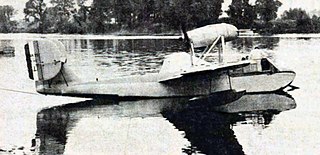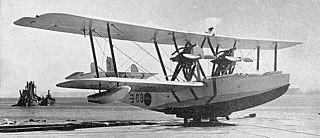
The Supermarine Scapa was a British general reconnaissance flying boat built by Supermarine that was used by the Royal Air Force between 1935 and 1939. It was developed from the Southampton and formed the basis of the later Stranraer flying boat.
The Naval Aircraft Factory TF was an American twin-engine flying-boat escort fighter first flown in October 1920. The aircraft originated from requirements drafted by the British Technical Committee in April 1918, after discussion approved the development of a long-range seaborne fighter capable of escorting Allied maritime reconnaissance sorties over the North Sea and Atlantic regions.

The Gourdou-Leseurre GL-832 HY was a 1930s French light shipboard reconnaissance floatplane designed and built by Gourdou-Leseurre for the French Navy.
The Donnet-Denhaut flying boat was a maritime patrol and anti-submarine warfare aircraft produced in France during the First World War. Known at the time simply as "Donnet-Denhaut" or "DD" flying boats, the DD-2, DD-8, DD-9, and DD-10 designations were applied retrospectively to denote the various changes in configuration made during their service life.
The Hiro G2H was a 1930s Japanese bomber or reconnaissance monoplane designed and built by the Hiro Naval Arsenal for the Imperial Japanese Navy.

The FBA Type A and the similar Type B and C were a family of reconnaissance flying boats produced in France prior to and during World War I. All three were unequal-span pusher biplane flying boats with a single step hull made of ash longerons covered in laminated wood, divided by bulkheads into eight compartments. The empennage was carried on an upswept curved extension of the hull made from steel tubing. The pilot and observer sat side by side in the open cockpit.

The FBA Type H was a French reconnaissance flying boat produced in large numbers in France and Italy during World War I by Franco-British Aviation.

The SCAN 20 was a 1940s French flying-boat training monoplane designed and built by Société de Constructions Aéro-Navales de Port-Neuf (SCAN). The prototype was built in secret in 1941. It was hidden until the liberation of France and first flown in 1945.
The Hiro H4H was a 1930s Japanese bomber or reconnaissance monoplane flying boat designed and built by the Hiro Naval Arsenal for the Imperial Japanese Navy.

The Hiro H1H was a 1920s Japanese bomber or reconnaissance biplane flying boat developed from the Felixstowe F.5 by the Hiro Naval Arsenal for the Imperial Japanese Navy. The aircraft were built by Hiro, the Yokosuka Naval Arsenal and Aichi.

The Hiro H2H, or "Navy Type 89 Flying boat", was a Japanese patrol flying boat of the 1930s. Designed and built by the Hiro Naval Arsenal, it was a twin-engined biplane that was operated by the Imperial Japanese Navy.
The Bréguet 790 Nautilus was a prototype French three-seat coastal patrol flying-boat designed and built by Bréguet Aviation to meet a requirement from the French navy.

The Kawanishi E11K was a Japanese flying boat of the 1930s. It was designed as a night reconnaissance aircraft for the Imperial Japanese Navy, but was not accepted, the two aircraft built being used as transports as the Type 96 Transport Flying Boat during the Second World War.

The Hispano Suiza E-30, later renamed Hispano E-30, was designed in Spain in 1930 as a multi-purpose intermediate trainer. It was a single engine, parasol wing monoplane. About 25 served with the Spanish armed forces until 1945.

The Hispano-Suiza E-34, later renamed Hispano HS-34, was a Spanish single engine, tandem seat biplane, designed as a basic trainer. Twenty five were ordered by the Aeronáutica Naval, but only five had been completed when the Spanish Civil War intervened.

The Lioré et Olivier H-23-2 was an amphibious maritime reconnaissance flying boat, built in France in 1932. Three were produced for the Venezuelan Army Air Service.

The Lioré et Olivier LeO H-23 was a French military flying boat, primarily intended for coastal reconnaissance, though able to carry a small bomb load. Only one was built.

The CAMS 54 was a strengthened and more powerful version of the French CAMS 51 civil transport and naval reconnaissance flying boat, developed for transatlantic flights. It is sometimes referred to as the 54 GR.

The Rohrbach Ro III was a twin-engined, all-metal flying boat built in Germany in the mid-1920s. A development of the Ro II, it could be configured either as an airliner or a reconnaissance aircraft. It was developed into the similar but more powerful Ro IIIa Rodra, intended only as a military reconnaissance/bomber. Four Ro IIIs were bought by Japan and two Rodras by Turkey.
The Itoh Emi 31 was a one-off Japanese civil flying boat first flown in 1922. Operated by an airline on a scheduled route for two years apart from a short break serving a newspaper, it could carry up to three passengers.














